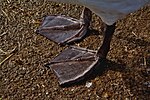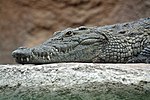Locomotion may refer to: Motion (physics) Robot locomotion, of man-made devices Aquatic locomotion Flight Locomotion in space Terrestrial locomotion Animal... 2 KB (252 words) - 00:41, 27 September 2023 |
 | Snake (redirect from Snake locomotion) Lateral undulation is the sole mode of aquatic locomotion, and the most common mode of terrestrial locomotion. In this mode, the body of the snake alternately... 150 KB (15,043 words) - 02:22, 27 April 2024 |
 | Webbed foot (section Terrestrial locomotion) specialized limb with interdigital membranes (webbings) that aids in aquatic locomotion, present in a variety of tetrapod vertebrates. This adaptation is... 27 KB (3,158 words) - 19:37, 21 February 2024 |
 | Terrestrial locomotion has evolved as animals adapted from aquatic to terrestrial environments. Locomotion on land raises different problems than that... 32 KB (4,157 words) - 13:07, 11 March 2024 |
 | Fin and flipper locomotion occurs mostly in aquatic locomotion, and rarely in terrestrial locomotion. From the three common states of matter — gas, liquid... 10 KB (1,436 words) - 02:01, 4 March 2022 |
 | Flipper (anatomy) (section Locomotion) broad, flattened limb adapted for aquatic locomotion. It refers to the fully webbed, swimming appendages of aquatic vertebrates that are not fish. In... 15 KB (1,656 words) - 07:53, 22 March 2024 |
 | Spinosaurus (section Locomotion and posture) Lauder, George V.; Pierce, Stephanie E. (May 7, 2020). "Tail-propelled aquatic locomotion in a theropod dinosaur". Nature. 581 (7806): 67–70. Bibcode:2020Natur... 89 KB (9,973 words) - 21:00, 26 April 2024 |
 | Bio-inspired robotics (category Robot locomotion) Bio-inspired robotic locomotion is a fairly new[citation needed] subcategory of bio-inspired design. It is about learning concepts from nature and applying... 26 KB (3,194 words) - 20:24, 3 October 2023 |
 | Pakicetus (section Possible semi-aquatic nature) Hussain, S. T.; Arif, M. (1994). "Fossil Evidence for the Origin of Aquatic Locomotion in Archaeocete Whales". Science. 263 (5144): 210–212. doi:10.1126/science... 17 KB (1,722 words) - 13:34, 11 April 2024 |
 | (1996). "Mechanics of propulsion by multiple fins: kinematics of aquatic locomotion in the burrfish (Chilomycterus schoepfi)". Proceedings of the Royal... 28 KB (3,030 words) - 22:53, 7 April 2024 |
 | Fish (category Aquatic ecology) M.; Davies, J. B. C. (1999). "Review of Fish Swimming Modes for Aquatic Locomotion" (PDF). IEEE Journal of Oceanic Engineering. 24 (2): 237–252. Bibcode:1999IJOE... 101 KB (10,032 words) - 03:01, 24 April 2024 |
 | Tetrapod (section Locomotion) but these were all aquatic. The first crown-tetrapods (last common ancestors of extant tetrapods capable of terrestrial locomotion) appeared by the very... 101 KB (10,229 words) - 14:34, 6 April 2024 |
was inspired by those of Neon Genesis Evangelion and invertebrate aquatic locomotion among sea creatures such as jellyfish, octopuses and squid, to imagine... 148 KB (11,926 words) - 01:59, 16 April 2024 |
 | Tail sailing (category Aquatic locomotion) Tail sailing refers to the action of whales lifting their tails clear of the water for long periods of time. The process is rarely observed by humans,... 2 KB (162 words) - 16:30, 22 October 2023 |
 | medial, unpaired fin that is located on the midline of the backs of some aquatic vertebrates. In development of the embryo in teleost fish, the dorsal fin... 7 KB (819 words) - 21:07, 12 April 2024 |
 | Pinniped (section Locomotion) otter, but shows evidence of quadrupedal swimming—retaining a form of aquatic locomotion that led to those employed by modern pinnipeds. Potamotherium, which... 106 KB (12,614 words) - 16:57, 24 March 2024 |
 | Crocodile (section Locomotion) functional equivalent of a diaphragm by incorporating muscles used for aquatic locomotion into respiration. Salt glands are present in the tongues of crocodiles... 106 KB (9,645 words) - 09:24, 12 April 2024 |













